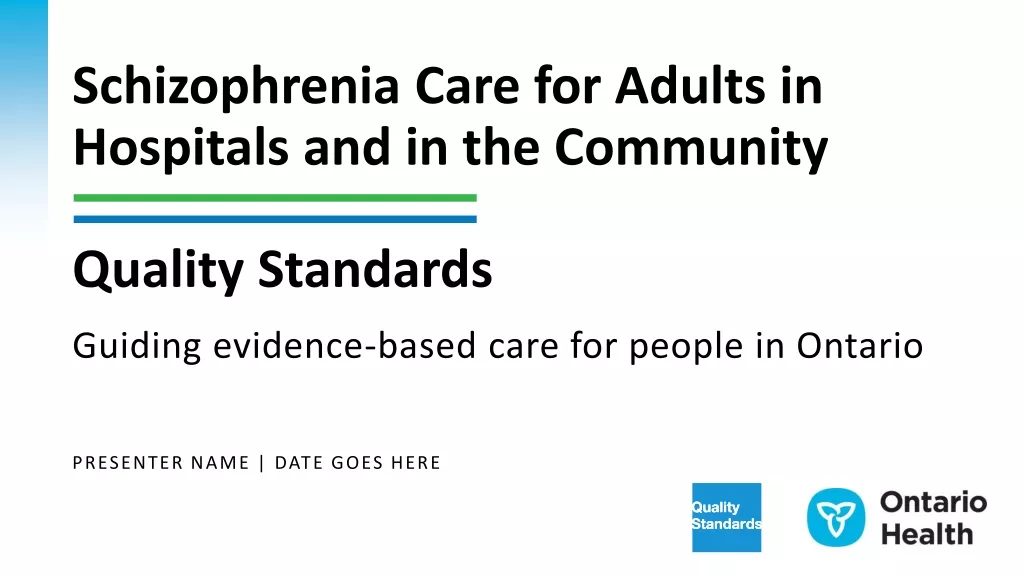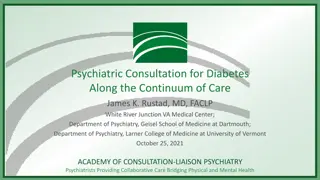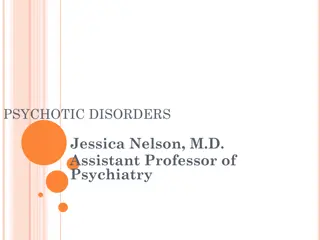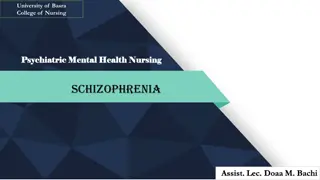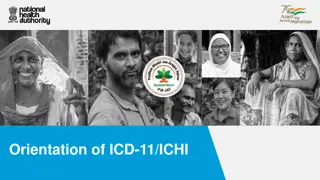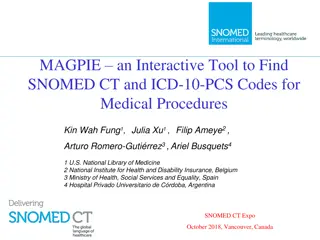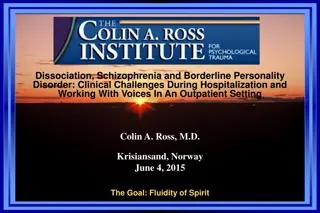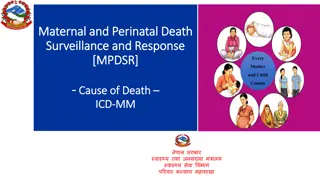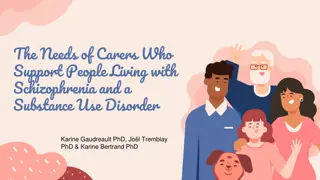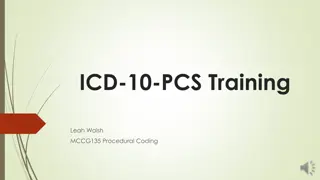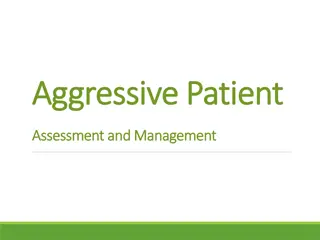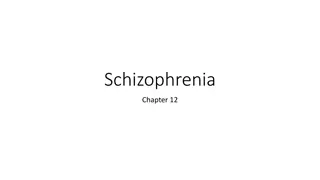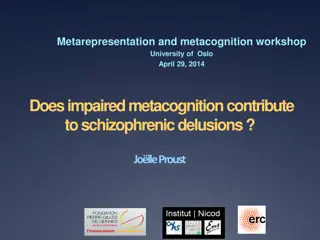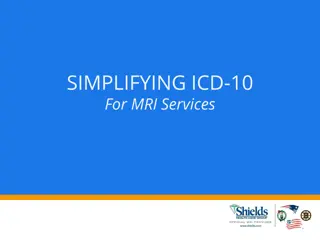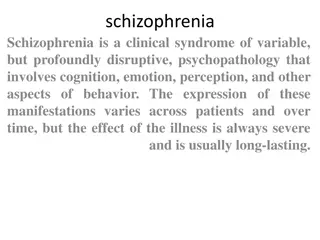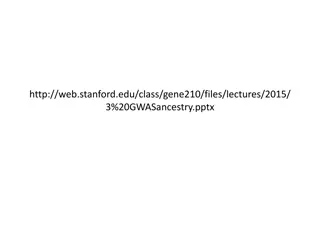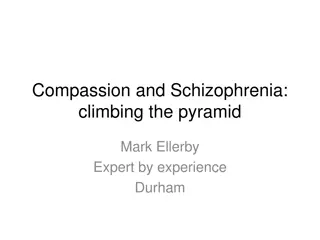Understanding Changes in Classification of Schizophrenia from ICD-10 to ICD-11
Schizophrenia, a complex mental disorder, has been classified differently in the ICD-10 and ICD-11 manuals. This article explores the diagnostic criteria for schizophrenia in both classifications, highlighting the changes made in the transition. It discusses the epidemiology of schizophrenia, prevalence rates in Nigeria, and the impact of this disorder on individuals. Dive into the objectives, introduction, and key information regarding the classification changes in schizophrenia to broaden your understanding of this condition.
Download Presentation

Please find below an Image/Link to download the presentation.
The content on the website is provided AS IS for your information and personal use only. It may not be sold, licensed, or shared on other websites without obtaining consent from the author. Download presentation by click this link. If you encounter any issues during the download, it is possible that the publisher has removed the file from their server.
E N D
Presentation Transcript
ICD 11 CHANGES IN CLASSIFICATION OF MENTAL BEHAVIOURAL AND NEURODEVELOPMENTAL DISORDERS SCHIZOPHRENIA IGBINOVIA IKPONMWOSA SHERIFAT
OUTLINE OBJECTIVES INTRODUCTION EPIDERMIOLOGY ICD 10 DIAGNOSTIC CRITERIA OF SCHIZOPHRENIA ICD 11 DIAGNOSTIC CRITRERIA OF SCHIZOPHRENIA CHANGES FROM ICD-10 TO ICD-11 CONCLUSION REFERENCES
OBJECTIVES To understand the ICD-10 classification of schizophrenia To understand the ICD-11 classification of schizophrenia To discuss the changes that has been made from ICD 10 to ICD 11.
INTRODUCTION Schizophrenia is a disorder that is characterized by distortions of thinking, and perception and by an inappropriate or blunted affect. The disturbances often affects basic functions that gives a person a feeling of individuality , uniqueness and self direction. The international classification of disease manual originated in the 19th century and it has been a basis for comparable statistics on the causes of mortality and morbidity around the world overtime. The latest version ICD-11 was adopted by he 72ndworld health assembly in 2019 and its use came into effect on 1stJanuary, 2022.
EPIDERMIOLOGY According to WHO, schizophrenia affects about 1 in 300 people ( 0.32%) of the the worlds population. Its not as common as many other mental disorders and onset is most often during late adolescence and the twenties and onset tends to happen earlier among men compared to women. In Nigeria, a cross- sectional study carried out in Madonna university teaching hospital between January 2014 to December 2016, it revealed a prevalence rate of 21.6% amongst all the psychiatric disorders seen in the time frame. Another cross- sectional study done in Obafemi Awolowo university teaching hospital in 2019 revealed an estimate of 0.4% prevalence rate in Nigeria.
ICD 1O DIAGNOSTIC CRITERIA OF SCHIZOPHRENIA (F20) Symptoms are divided into groups. CATEGORY A SYMPTOMS (A-D) (a) thought echo, thought insertion or withdrawal, and thought broadcasting; (b)delusions of control, influence, or passivity, clearly referred to body or limb movements or specific thoughts, actions, or sensations; delusional perception;
ICD 10 (c)hallucinatory voices giving a running commentary on the patient's behaviour, or discussing the patient among themselves, or other types of hallucinatory voices coming from some part of the body; (d)persistent delusions of other kinds that are culturally inappropriate and completely impossible, such as religious or political identity, or superhuman powers and abilities (e.g. being able to control the weather, or being in communication with aliens from another world);
ICD 10 CATEGORY B SYMPTOMS ( E-I) (e)persistent hallucinations in any modality, when accompanied either by fleeting or half-formed delusions without clear affective content, or by persistent over-valued ideas, or when occurring every day for weeks or months on end; (f)breaks or interpolations in the train of thought, resulting in incoherence or irrelevant speech, or neologisms; (g)catatonic behaviour, such as excitement, posturing, or waxy flexibility, negativism, mutism, and stupor;
ICD 10 CONTD (h)"negative" symptoms such as marked apathy, paucity of speech, and blunting or incongruity of emotional responses, usually resulting in social withdrawal and lowering of social performance; it must be clear that these are not due to depression or to neuroleptic medication; (i)a significant and consistent change in the overall quality of some aspects of personal behaviour, manifest as loss of interest, aimlessness, idleness, a self-absorbed attitude, and social withdrawal.
ICD 10 CONTD The diagnostic criteria of schizophrenia; a minimum of one very clear symptom (and usually two or more if less clear-cut) belonging to any one of the groups listed as (a) to (d) above, or symptoms from at least two of the groups referred to as (e) to (h), Symptoms should have been present for a period of 1 month or more.
ICD 10 CONTD Pattern of course The course of schizophrenic disorders can be classified by using the following five- character codes: F20.x0 Continuous F20.x1 Episodic with progressive deficit F20.x2 Episodic with stable deficit F20.x3 Episodic remittent F20.x4 Incomplete remission F20.x5 Complete remission F20.x8 Other F20.x9 Course uncertain, period of observation too short
ICD 10 CONTD SUBTYPES F20.0 Paranoid schizophrenia F20.1 Hebephrenic schizophrenia F20.2 Catatonic schizophrenia F20.3 Undifferentiated schizophrenia F20.4 Post-schizophrenic depression F20.5 Residual schizophrenia F20.6 Simple schizophrenia F20.8 Other schizophrenia F20.9 Schizophrenia, unspecified
ICD 10 CLASSIFICATION CONTD F25 Schizoaffective disorders These are episodic disorders in which both affective and schizophrenic symptoms are prominent within the same episode of illness, preferably simultaneously, but at least within a few days of each other. The diagnostic criteria includes; Prominent elevation of mood, or a less obvious elevation of mood combined With increased irritability or excitement. Within the same episode, at least one and preferably; Two typically schizophrenic symptoms (as specified for schizophrenia (F20.-), diagnostic guidelines (a)-(d)) should be clearly present.
ICD 10 CLASSIFICATION CONTD F25.0 Schizoaffective disorder, manic type There must be a prominent elevation of mood, or a less obvious elevation of mood with increased irritability or excitement. Within the same episode, at least one and preferably two typically schizophrenic symptoms (as specified for schizophrenia (F20.-), diagnostic guidelines (a)-(d)) should be clearly present. F25.1 Schizoaffective disorder, depressive type There must be prominent depression, accompanied by at least two characteristic depressive symptoms or associated behavioural abnormalities as listed for depressive episode Occuring within the same episode, at least one and preferably two typically schizophrenic symptoms (as specified for schizophrenia (F20), diagnostic guidelines (a)-(d)) should be clearly present.
ICD 10 CLASSIFICATION CONTD F25.2 Schizoaffective disorder, mixed type F25.8 Other schizoaffective disorders F25.9 Schizoaffective disorder, unspecified
ICD 11 CLASSIFICATION OF SCHIZOPHRENIA ( 6A20) Schizophrenia is characterized by disturbances in multiple mental modalities, Includes thinking (e.g., delusions, disorganization in the form of thought) perception (e.g., hallucinations) self-experience (e.g., the experience that one s feelings, impulses, thoughts, or behaviour are under the control of an external force) cognition (e.g., impaired attention, verbal memory, and social cognition), volition (e.g., loss of motivation)
ICD 11 CHANGES CONTD Affect (e.g., blunted emotional expression) Behaviour (e.g.,behaviour that appears bizarre or purposeless, unpredictable or inappropriate emotional responses that interfere with the organization of behaviour). Psychomotor disturbances, including catatonia, may be present. Persistent delusions, persistent hallucinations, thought disorder, and experiences of influence, passivity, or control are considered core symptoms.
ICD-11 CHANGES CONTD 6A20.0 Schizophrenia 1stepisode. This includes symptoms that meets the diagnostic requirements for schizophrenia Including the duration of 1 month. Occurring for the first time. 6A20.00 Schizophrenia, first episode, currently symptomatic All definitional requirements for Schizophrenia, first episode in terms of symptoms and duration are currently met, or have been met within the past one month.
ICD 11 CHANGES CONTD 6A20.01 Schizophrenia, first episode, in partial remission All definitional requirements for Schizophrenia, first episode in terms of symptoms and duration were previously met. Symptoms have ameliorated such that the diagnostic requirements for the disorder have not been met for at least one month, but some clinically significant symptoms remain, which may or may not be associated with functional impairment. The partial remission may have occurred in response to medication or other treatment. 6A20.02 Schizophrenia, first episode, in full remission All Symptoms have ameliorated such that no significant symptoms remain. The remission may have occurred in response to medication or other treatment. 6A20.0Z Schizophrenia, first episode, unspecified.
ICD 11 CHANGES CONTD 6A20.1 Schizophrenia, multiple episodes Schizophrenia, multiple episode should be used to identify individuals experiencing symptoms that meet the diagnostic requirements for Schizophrenia (including duration). who have also previously experienced episodes during which diagnostic requirements were met, with substantial remission of symptoms between episodes. Some attenuated symptoms may remain during periods of remission. Remissions may have occurred in response to medication or other treatment.
ICD 11 CHANGES CONTD 6A20.10 Schizophrenia, multiple episodes, currently symptomatic All definitional requirements for Schizophrenia, multiple episodes in terms of symptoms and duration are currently met, or have been met within the past one month. 6A20.11 Schizophrenia, multiple episodes, in partial remission Symptoms have ameliorated such that the diagnostic requirements for the disorder have not been met for at least one month, but some clinically significant symptoms remain, which may or may not be associated with functional impairment. The partial remission may have occurred in response to medication or other treatment.
ICD 11 CHANGES CONTD 6A20.12 Schizophrenia, multiple episodes, in full remission Symptoms have ameliorated such that no significant symptoms remain. The remission may have occurred in response to medication or other treatment. 6A20.1Z Schizophrenia, multiple episodes, unspecified
ICD 11 CHANGES CONTD 6A20.2 Schizophrenia, continuous Symptoms fulfilling all definitional requirements of Schizophrenia have been present for almost all of the illness course over a period of at least one year, with periods of subthreshold symptoms being very brief relative to the overall course. 6A20.20 Schizophrenia, continuous, currently symptomatic All definitional requirements for Schizophrenia, continuous in terms of symptoms and duration are currently met, or have been met within the past one month.
ICD 11 CHANGES CONTD 6A20.21 Schizophrenia, continuous, in partial remission Symptoms have ameliorated such that the diagnostic requirements for the disorder have not been met for at least one month, but some clinically significant symptoms remain, which may or may not be associated with functional impairment. The partial remission may have occurred in response to medication or other treatment. 6A20.22 Schizophrenia, continuous, in full remission Symptoms have ameliorated such that no significant symptoms remain. The remission may have occurred in response to medication or other treatment.
ICD 11 CHANGES CONTD 6A20.2Z Schizophrenia, continuous, unspecified 6A20.Y Other specified schizophrenia 6A20.Z
ICD 11 CHANGES CONTD 6A21. Schizoaffective disorder Schizoaffective disorder is an episodic disorder The diagnostic requirements of schizophrenia and a manic, mixed, or moderate or severe depressive episode are met within the same episode of illness, simultaneously or within a few days of each other. Prominent symptoms of Schizophrenia as well as those of the mood disorders are present including catatonia, may be present. Symptoms would have persisted for at least one month.
ICD 11 CHANGES CONTD 6A21.0 Schizoaffective disorder, first episode 6A21.00 Schizoaffective disorder, first episode, currently symptomatic 6A21.01 Schizoaffective disorder, first episode, in partial remission 6A21.02 Schizoaffective disorder, first episode, in full remission 6A21.0Z Schizoaffective disorder, first episode, unspecified
ICD 11 CHANGES CONTD 6A21.1 Schizoaffective disorder, multiple episodes 6A21.10 Schizoaffective disorder, multiple episodes, currently symptomatic 6A21.11 Schizoaffective disorder, multiple episodes, in partial remission 6A21.12 Schizoaffective disorder, multiple episodes, in full remission 6A21.1Z Schizoaffective disorder, multiple episodes, unspecified
ICD 11 CHANGES CONTD 6A21.2 Schizoaffective disorder, continuous 6A21.20 Schizoaffective disorder, continuous, currently symptomatic 6A21.21 Schizoaffective disorder, continuous, in partial remission 6A21.22 Schizoaffective disorder, continuous, in full remission 6A21.2Z Schizoaffective disorder, continuous, unspecified 6A21.Y Other specified schizoaffective disorder 6A21.Z Schizoaffective disorder, unspecified
ICD 11 CHANGES CONTD 6A25.5 Other specified schizophrenia or other primary psychotic disorders Catatonia (BlockL1-6A4) Extreme slowing or absence of motor activity Mutism Purposeless motor activity unrelated to external stimuli Assumption and maintenance of rigid, unusual or bizarre postures(posturing) Resistance to instructions or attempts to be moved, or automatic compliance with instructions.
ICD 11 CHANGES CONTD 6A40. Catatonia associated with another mental disorder Can be diagnosed in the context of other specific mental disorders like schizophrenia, mood disorders, Autism spectrum disorders. NOTE: code also the underlying condition 6A41. Catatonia induced by psychoactive substances, including medications Catatonia symptoms that occurs during or shortly after the consumption of a psychoactive substance or during use of a psychoactive medication. 6A4Z. Catatonia, unspecified
CHANGES FROM ICD-10 TO ICD- 11 A. The coding for schizophrenia has been changed from F20 to 6A20. The category of symptoms into A & B has been removed and the symptoms were just listed and considered as core symptoms and should have lasted for at least a month. The subtypes for schizophrenia and the schizoaffective disorders were removed and replaced with episodic occurrences with its pattern of course. Catatonic schizophrenia subtype( F20.2) was replaced with just catatonia Block (BlockL1-6A4) with its substypes 1. Catatonia associated with a mental illness (6A40) 2. Catatonia induced by psychoactive substances, including medications (6A41) 3. Catatonia unspecified (6A4Z)
CONCLUSION The International classification of diseases is an important tool which provides a common language for recording, reporting and monitoring diseases. The revised version 11 simplifies the classification of schizophrenia and this will inturn aid in better diagnosis of the condition and improve the overall outcome of the disorder in terms of treatment .
REFERENCES 1. https://www.who.int/standards/classifications/classification-of-diseases 2. https://www.ncbi.nlm.nih.gov/pmc/articles/PMC6337973/ 3. Harrison, P. H. & Cowen, P. C. (2018). Shorter oxford textbook of psychiatry (7ed.). Great Clarendon Street, Oxford, OX2 6DP, United Kingdom: Oxford. 4. ICD 10 Classification of mental and behavioural disorders; clinical Descriptions and diagnostic guidelines. World health organisation 5. ICD 11 Classification of mental and behavioural disorders. Diagnostic criteria for research. World health organisation; Geneva









